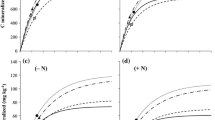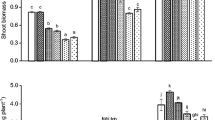Abstract
Legumes have been shown to increase P uptake of the following cereal, but the underlying mechanisms are unclear. The aim of this study was to compare the effect of legume pre-crops and their residues on the growth, P uptake and size of soil P pools in the rhizosphere of the following wheat. Three grain legumes (faba bean, chickpea and white lupin) were grown until maturity in loamy sand soil with low P availability to which 80 mg P kg−1 was supplied. This pre-crop soil was then amended with legume residues or left un-amended and planted with wheat. The growth, P uptake and concentrations of P pools in the rhizosphere of the following wheat were measured 6 weeks after sowing. In a separate experiment, residue decomposition was measured over 42 days by determining soil CO2 release as well as available N and P. Decomposition rates were highest for chickpea residues and lowest for wheat residues. P release was greatest from white lupin residues and N release was greatest from faba bean residues, while wheat residues resulted in net N and P immobilisation. The growth of the following wheat was greater in legume pre-crop soil without residue than in soils with residue addition, while the reverse was true for plant P concentration. Among the legumes, faba bean had the strongest effect on growth, P uptake and concentrations of the rhizosphere P pools of the following wheat. Regardless of the pre-crop and residue treatment, wheat depleted the less labile pools residual P as well as NaOH-Pi and Po, with a stronger depletion of the organic pool. We conclude that although P in the added residues may become available during decomposition, the presence of the residues in the soil had a negative effect on the growth of the following wheat. Further, pre-crops or their residues had little effect on the size of P pools in the rhizosphere of wheat.




Similar content being viewed by others
References
Bradstreet RB (1965) The Kjeldahl method for organic nitrogen. Academic, New York
Brady NC, Weil RR (2002) The nature and properties of soils, 13th edn. Prentice Hall, Upper Saddle Hall, NJ
Bremner J (1965) Total nitrogen. In: Black C (ed) Methods of soil analysis, part 2. Am. Soc. Agron., Madison, WI, pp 1149–1178
Bünemann E, Marschner P, Smernik RJ, Conyers M, McNeill AM (2008) Soil organic phosphorus and microbial community composition as affected by 26 years of different management strategies. Biol Fertil Soils 44:717–726
Cheshire MV, Chapman SJ (1996) Influence of the N and P status of plant material and of added N and P on the mineralization of C from 14C-labelled ryegrass in soil. Biol Fertil Soils 21:166–170
Chou C-H, Patrick ZA (1976) Identification and phytotoxic activity of compounds produced during decomposition of corn and rye residues in soil. J Chem Ecol 2:369–387
Fierer N, Schimel JP, Holden PA (2003) Influence of drying–rewetting frequency on soil bacterial community structure. Microb Ecol 45:63–71
George TS, Gregory PJ, Wood M, Read D, Buresh RJ (2002) Phosphatase activity and organic acids in the rhizosphere of potential agroforestry species and maize. Soil Biol Biochem 34:1487–1494
George TS, Richardson AE, Simpson RJ (2005) Behaviour of plant-derived extracellular phytase upon addition to soil. Soil Biol Biochem 37:977–988
Gerke J (1992) Phosphate, aluminium and iron in the soil solution of three different soils in relation to varying concentrations of citric acid. Zeitsch Pflanzenern Bdkde 155:339–343
Graham PH, Vance CP (2003) Legumes: importance and constraints to greater use. Plant Physiol 131:872–877
Hafner H, George E, Bationo A, Marschner H (1993) Effect of crop residues on root-growth and phosphorus acquisition of pearl-millet in an acid sandy soil in Niger. Plant Soil 150:117–127
Hanson WC (1950) The photometric determination of phosphorus in fertilizers using the phosphovanado–molybdate complex. J Sci Food Agric 1:172–173
Hedley MJ, Stewart JWB, Chauhan BS (1982) Changes in inorganic and organic soil-phosphorus fractions induced by cultivation practices and by laboratory incubations. Soil Sci Soc Am J 46:970–976
Henrikson A, Selmer-Olsen AR (1970) Automatic methods for determining nitrate and nitrite in water and soil extracts. Analyst 95:514–518
Horst WJ, Kamh M, Jibrin JM, Chude VO (2001) Agronomic measures for increasing P availability to crops. Plant Soil 237:211–223
Hu HQ, Tang CX, Rengel Z (2005) Role of phenolics and organic acids in phosphorus mobilization in calcareous and acidic soils. J Plant Nutrition 28:1427–1439
Jones DL (1998) Organic acids in the rhizosphere—a critical review. Plant Soil 205:25–44
Jones DL, Edwards AC (1998) Influence of sorption on the biological utilization of two simple carbon substrates. Soil Biol Biochem 30:1895–1902
Jones DL, Dennis PG, Owen AG, van Hees PAW (2003) Organic acid behavior in soils—misconceptions and knowledge gaps. Plant Soil 248:31–41
Kamh M, Horst W, Amer F, Mostafa H, Maier P (1999) Mobilization of soil and fertilizer phosphate by cover crops. Plant Soil 211:19–27
Kamh M, Abdou M, Chude V, Wiesler F, Horst WJ (2002) Mobilization of phosphorus contributes to positive rotational effects of leguminous cover crops on maize grown on soils from northern Nigeria. J Plant Nutrition Soil Sci-Zeitsch Pflanzenern Bdkde 165:566–572
Keeney DR, Nelson DW (1982) Nitrogen—inorganic forms. In: Page AL, Miller RH, Keeney DR (eds) Methods of soil analysis, 2nd edn. American Society of Agronomy, Madison, WI, pp 643–698
Kouno K, Tuchiya Y, Ando T (1995) Measurement of soil microbial biomass phosphorus by an anion exchange membrane method. Soil Biol Biochem 27:1353–1357
Kuo S (1996) Phosphorus. In: Sparks DL (ed) Methods of soil analysis. SSSA/ASA, Madison, WI, pp 869–919
Linquist BA, Singleton PW, Cassman KG (1997) Inorganic and organic phosphorus dynamics during a build-up and decline of available phosphorus in an ultisol soil. Soil Sci 162:254–264
Mat Hassan H, Marschner P, McNeill A, Tang C (2011) Growth, P uptake in grain legumes and changes in rhizosphere soil P pools. Biol Fertil Soils 48:151–159
Murphy J, Riley JP (1962) A modified single solution method for the determination of phosphate in natural waters. Anal Chim Acta 27:31–36
Nuruzzaman M, Lambers H, Bolland MDA, Veneklaas EJ (2005a) Phosphorus benefits of different legume crops to subsequent wheat grown in different soils of Western Australia. Plant Soil 271:175–187
Nuruzzaman M, Lambers H, Bolland MDA, Veneklaas EJ (2005b) Phosphorus uptake by grain legumes and subsequently grown wheat at different levels of residual phosphorus fertiliser. Aus J Agric Res 56:1041–1047
Nziguheba G, Merckx R, Palm CA, Rao MR (2000) Organic residues affect phosphorus availability and maize yields in a nitisol of western Kenya. Biol Fertil Soils 32:328–339
Parnas H (1975) Model for decomposition of organic material by microorganisms. Soil Biol Biochem 7:161–169
Pearse SJ, Veneklaas EJ, Cawthray GR, Bolland MDA, Lambers H (2006) Carboxylate release of wheat, canola and 11 grain legume species as affected by phosphorus status. Plant Soil 288:127–139
Richardson AE (2001) Prospects for using soil microorganisms to improve the acquisition of phosphorus by plants. Aus J Plant Physiol 28:897–906
Richardson AE, Hadobas PA, Hayes JE (2001) Extracellular secretion of Aspergillus phytase from Arabidopsis roots enables plants to obtain phosphorus from phytate. Plant J 25:641–649
Rose T, Hardiputra B, Rengel Z (2010) Wheat, canola and grain legume access to soil phosphorus fractions differs in soils with contrasting phosphorus dynamics. Plant Soil 326:159–170
Searle PL (1984) The Berthelot or indophenol reaction and its use in the analytical chemistry of nitrogen. A review Analyst 109:549–568
Ström L, Owen AG, Godbold DL, Jones DL (2001) Organic acid behaviour in a calcareous soil: sorption reactions and biodegradation rates. Soil Biol Biochem 33:2125–2133
Tian G, Kang B, Brussaard L (1992) Biological effects of plant residues with contrasting chemical compositions under humid tropical conditions—decomposition and nutrient release. Soil Biol Biochem 24:1051–1060
Tiessen H, Moir JO (1993) Characterization of available P by sequential extraction. In: Carter MR (ed) Soil sampling and methods of analysis. Lewis, Boca Raton, FL, pp 75–86
Vu DT, Tang C, Armstrong RD (2008) Changes and availability of P fractions following 65 years of P application to a calcareous soil in a Mediterranean climate. Plant Soil 304:21–33
Wang X, Lester DW, Guppy CN, Lockwood PV, Tang C (2007) Changes in phosphorus fractions at various soil depths following long-term P fertiliser application on a black vertosol from south-eastern Queensland. Aus J Soil Res 45:524–532
Wang Z, Shen J, Zhang F (2006) Cluster-root formation, carboxylate exudation and proton release of Lupinus pilosus Murr. as affected by medium pH and P deficiency. Plant Soil 287:247–256
Wichern F, Mayer J, Joergensen RG, Müller T (2007) Release of C and N from roots of peas and oats and their availability to soil microorganisms. Soil Biol Biochem 39:2829–2839
Xu JM, Tang C, Chen ZL (2006) The role of plant residues in pH change of acid soils differing in initial pH. Soil Biol Biochem 38:709–719
Acknowledgements
The research was supported by the Australian Research Council. HMH acknowledges the support from Ministry of Higher Education Malaysia and Universiti Sains Malaysia for her studies.
Author information
Authors and Affiliations
Corresponding author
Rights and permissions
About this article
Cite this article
Mat Hassan, H., Marschner, P., McNeill, A. et al. Grain legume pre-crops and their residues affect the growth, P uptake and size of P pools in the rhizosphere of the following wheat. Biol Fertil Soils 48, 775–785 (2012). https://doi.org/10.1007/s00374-012-0671-8
Received:
Revised:
Accepted:
Published:
Issue Date:
DOI: https://doi.org/10.1007/s00374-012-0671-8




